P.S. Melbourne
Regular subscribers will be aware that Anne has written many posts on art relating to the word Melbourne.
To continue that theme, I have another Melbourne: this one graces the waterways of the Murray River - the longest river in Australia which rises in the Australian Alps, divides the states of Victoria and New South Wales and meanders through South Australia to finally ends its journey in the Great Australian Bight.
I love the story that surrounds the paddle steamer named P.S. Melbourne. Yes, a paddle steamer that has a history of over 100 years and thanks to the passion of the Pointon family it carries passengers today. The shipwrights (a carpenter skilled in ship construction and repair) and the Pointon family are artisans in their own right. For example, replacing a plank from a paddle steamer can take days and lots of ingenuity. Keeping a steam engine and boiler in top condition, meeting safety approvals of 2021 when it is 110 years old employs a totally different set of skills, equally amazing.
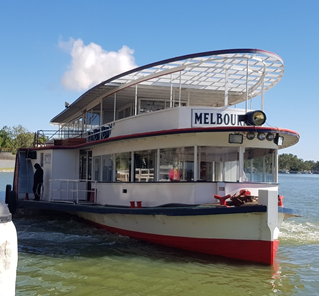
The Paddle Steamer Melbourne was originally launched at Koondrook on the River Murray in 1912. Built for the Victorian Government as a work boat, the Melbourne was fitted with a huge winch which was used for hauling fallen trees and snags from the river, keeping the main channel open for navigation for other paddle steamers. The Melbourne was used for any public works along the river, assisting with bridge, weir and lock construction.1

Later the Melbourne was bought by Evans Brothers Timber Mills at Echuca and was used for logging until road transport became more viable. In 1939 after a sudden flood came down the Goulburn River, tons of logs became jammed against the Torrumbarry Weir. The Melbourne was brought back into service to help clear the weir of the massive amount of debris. She was then left permanently moored against the riverbank and at the mercy of the elements.1
It was in 1965 that Captain Ably Pointon purchased the P.S. Melbourne after searching along the Murray River for another paddle steamer to restore for his growing business at Mildura.
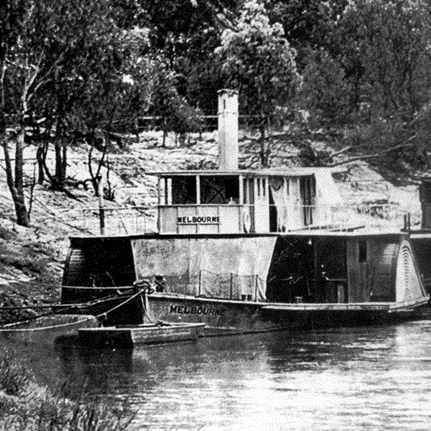
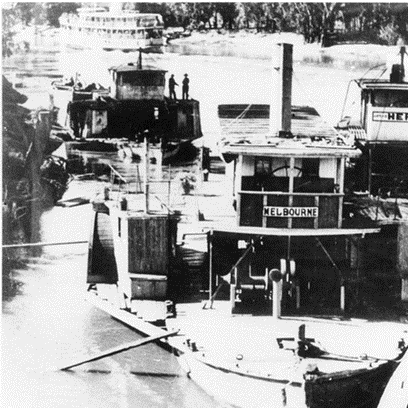
As a little aside and coincidence, the paddle steamer P.S.Edwards shown behind the P.S.Melbourne (above right) was captianed by Anne's great uncle Jim 'Big Did' Foster in the 1930s. But back to the story about the Melbourne.
The picture below shows the stern of the paddle steamer P.S. Melbourne, just after Alby Pointon purchased her in Echuca, 1965.
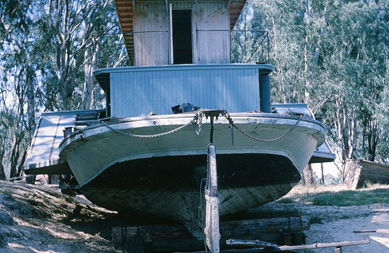
After extensive boiler and hull repairs, the Melbourne's boiler was fired again for the first time in 23 years for her long voyage from Echuca to Mildura. Upon arriving at Mildura, and after further careful restoration, the P.S. Melbourne departed Mildura Wharf on her maiden voyage of carrying passengers on the 1st January 1966.
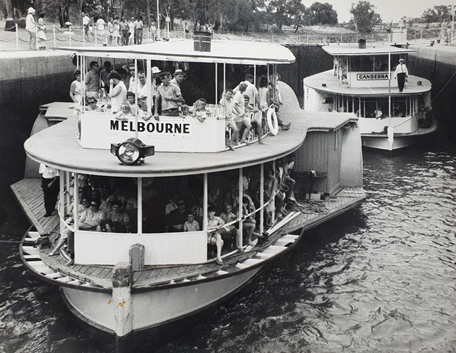

The paddle steamer Melbourne (below) is seen cruising past Drings Hill at Gol Gol. Captain Alby Pointon used this section of the river often for his promotional photographs. He was always adamant on capturing an image of the boat with the river surrounding it (no trees coming out of the roof), and on the bend so you could see the waves created by the paddles. He would make the captains on the day go around and around again and again, until he could capture the perfect photograph. These scenes were recreated numerous times throughout the years.2
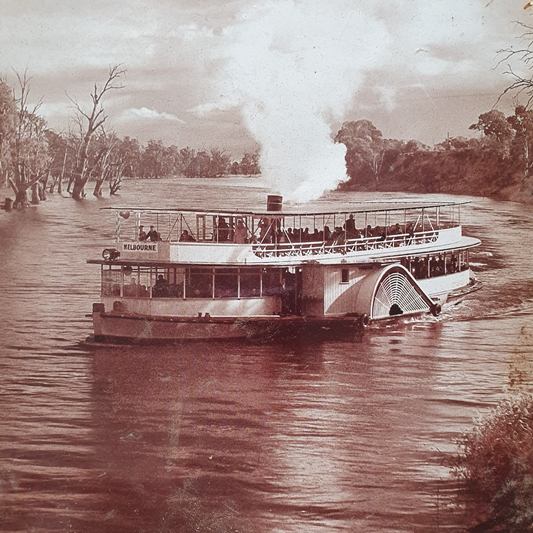
Of the 250 paddle steamers built and used on the River Murray, the P.S. Melbourne is now one of the few original paddle steamers left cruising daily on the river for passengers that is still driven by her original steam engine.
As I alluded to earlier, I am in awe of the skills required to keep these paddle steamers cruising the Murray. The Pointon family have operated river cruises in Mildura for over 64 years, with the management being handed on to their children and grandchildren. It is due to their love of these vessels that many skills are passed down to the next generation. They explain in detail in their blog what is involved to make a plank for the deck. If, like me, you would like to see the skill and ingenuity required, click here.
An explantion of how the plank is bent is explained below.
The process takes a few hours, but basically, the tube you can see below, gets filled with water, a fire is lit underneath, the water is brought to the boil (creating steam) and the plank is slowly put inside to boil and steam. Why do we need to do this!? This is how we get the planks to bend, without snapping. If you look at the shapes of our vessels, there aren't very many straight lines of wooden planks. Therefore, steaming the planks helps the shipwrights to bend the plank to the shape of the vessel.2
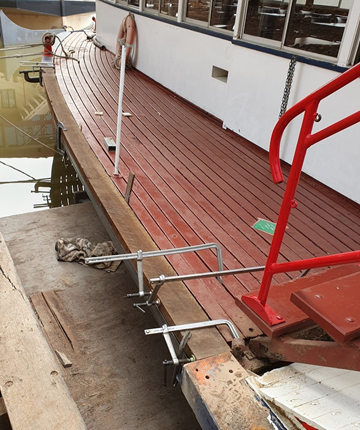
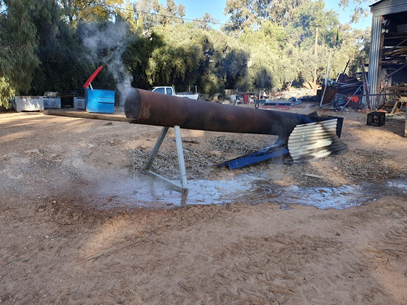
The paddle steamer Melbourne's engine had not turned over for 8 months (due to COVID and not being in operation). She has weathered dust storms and rain and in need of a tidy up cosmetically, but recently also passed her boiler inspection!
The stunning image of the Melbourne's steam engine and boiler was taken by a passenger Rochelle Challen. The engine was built in Gainsborough England in 1910, specifically for the P.S Melbourne and I think it is a beauty. The picture of the firebox of the P.S Melbourne was taken by someone who spends a lot of time with this type of engine, yes the photographer is a steam engineer, Zoe Bartsch.2
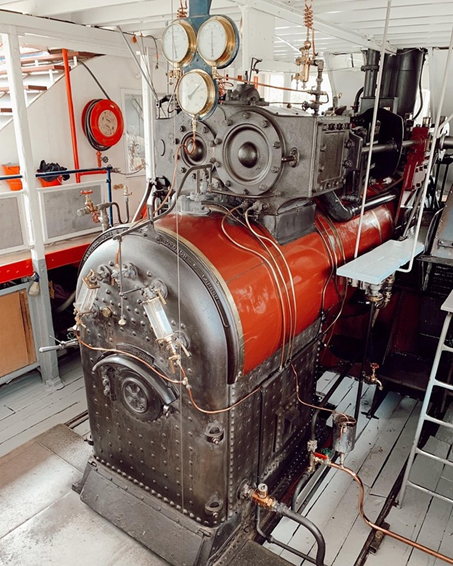
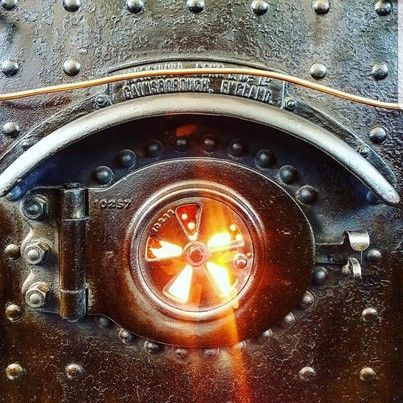
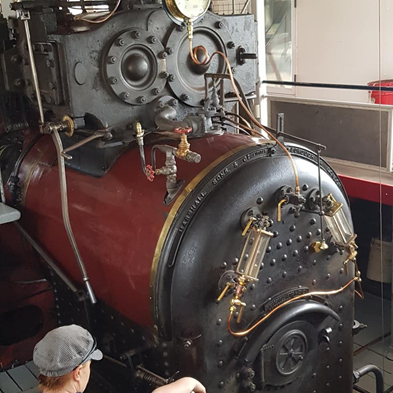
If you ever find yourself near Mildura, I would strongly recommend to jump on board one of these gloriously maintained paddle steamers and enjoy the beauty of the mighty Murray River. Toot toot!
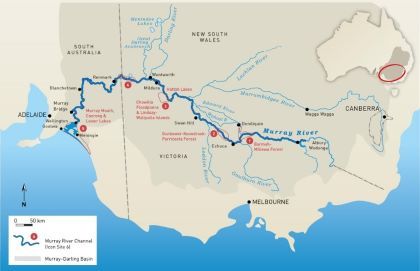
Fun Fact
Did you know that the Murray River is Australia’s longest river, at 2508 kilometres long!? It spans through the states of New South Wales, Victoria and South Australia. Almost 2000 km is navigable, making it the third longest navigable river on the planet, with only the Amazon and Nile rivers ahead of it.
Credits
1. murrayriver.com.au
2. paddlesteamers.com.au
